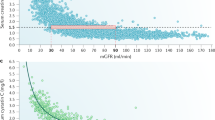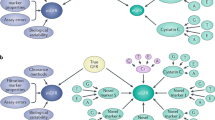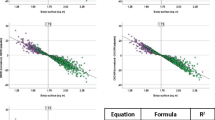Abstract
Background
Assessing bias (estimated – measured) is key to evaluating glomerular filtration rate (GFR). Stratification by subgroups can indicate where equations perform differently. However, there is a fallacy in the assessment of two instruments (e.g., eGFR and mGFR) when stratifying on the level of only one of those instruments. Here, we present statistical aspects of the problem and a solution for GFR stratification along with an empirical investigation using data from the CKiD study.
Methods
Compared and contrasted biases (eGFR relative to mGFR) with 95% confidence intervals within strata of mGFR only, eGFR only, and the average of mGFR and eGFR using data from the Chronic Kidney Disease in Children (CKiD) study.
Results
A total of 304 participants contributed 843 GFR studies with a mean mGFR of 48.46 (SD = 22.72) and mean eGFR of 48.67 (SD = 22.32) and correlation of 0.904. Despite strong agreement, eGFR significantly overestimated mGFR when mGFR < 30 (+ 6.2%; 95%CI + 2.9%, + 9.7%) and significantly underestimated when mGFR > 90 (–12.2%; 95%CI − 17.3%, − 7.0%). Significant biases in opposite direction were present when stratifying by eGFR only. In contrast, when stratifying by the average of eGFR and mGFR, biases were not significant (+ 1.3% and − 1.0%, respectively) congruent with strong agreement.
Conclusions
Stratifying by either mGFR or eGFR only to assess eGFR biases is ubiquitous but can lead to inappropriate inference due to intrinsic statistical issues that we characterize and empirically illustrate using data from the CKiD study. Using the average of eGFR and mGFR is recommended for valid inferences in evaluations of eGFR biases.
Graphical Abstract

A higher resolution version of the Graphical abstract is available as Supplementary information

Similar content being viewed by others
Data availability
Data from the Chronic Kidney Disease in Children cohort study [(V7)/https://doi.org/10.58020/dzq8-ct80] are available for request at the NIDDK Central Repository (NIDDK-CR) website, Resources for Research (R4R), https://repository.niddk.nih.gov/.
References
Levey AS, Inker LA, Coresh J (2014) GFR estimation: from physiology to public health. Am J Kidney Dis 63:820–834. https://doi.org/10.1053/j.ajkd.2013.12.006
Pierce CB, Muñoz A, Ng DK et al (2021) Age- and sex-dependent clinical equations to estimate glomerular filtration rates in children and young adults with chronic kidney disease. Kidney Int 99:948–956. https://doi.org/10.1016/j.kint.2020.10.047
Stevens LA, Zhang Y, Schmid CH (2008) Evaluating the performance of equations for estimating glomerular filtration rate. J Nephrol 21:797–807
Schwartz GJ, Muñoz A, Schneider MF et al (2009) New equations to estimate GFR in children with CKD. J Am Soc Nephrol 20:629–637. https://doi.org/10.1681/ASN.2008030287
Levey AS, Coresh J, Greene T et al (2006) Using standardized serum creatinine values in the modification of diet in renal disease study equation for estimating glomerular filtration rate. Ann Intern Med 145:247–254. https://doi.org/10.7326/0003-4819-145-4-200608150-00004
Levey AS, Stevens LA, Schmid CH et al (2009) A new equation to estimate glomerular filtration rate. Ann Intern Med 150:604–612
Stevens LA, Claybon MA, Schmid CH et al (2011) Evaluation of the chronic kidney disease epidemiology collaboration equation for estimating the glomerular filtration rate in multiple ethnicities. Kidney Int 79:555–562. https://doi.org/10.1038/ki.2010.462
Inker LA, Schmid CH, Tighiouart H et al (2012) Estimating glomerular filtration rate from serum creatinine and cystatin C. N Engl J Med 367:20–29. https://doi.org/10.1056/NEJMoa1114248
Inker LA, Wyatt C, Creamer R et al (2012) Performance of creatinine and cystatin C GFR estimating equations in an HIV-positive population on antiretrovirals. J Acquir Immune Defic Syndr 61:302–309. https://doi.org/10.1097/QAI.0b013e31826a6c4f
Inker LA, Eneanya ND, Coresh J et al (2021) New creatinine- and cystatin C–based equations to estimate GFR without race. N Engl J Med 385:1737–1749. https://doi.org/10.1056/NEJMoa2102953
Anderson AH, Yang W, Hsu C et al (2012) Estimating GFR among participants in the Chronic Renal Insufficiency Cohort (CRIC) Study. Am J Kidney Dis 60:250–261. https://doi.org/10.1053/j.ajkd.2012.04.012
Hsu C, Yang W, Go AS et al (2021) Analysis of estimated and measured glomerular filtration rates and the CKD-EPI equation race coefficient in the Chronic Renal Insufficiency Cohort Study. JAMA Netw Open 4:e2117080. https://doi.org/10.1001/jamanetworkopen.2021.17080
Pottel H, Hoste L, Dubourg L et al (2016) An estimated glomerular filtration rate equation for the full age spectrum. Nephrol Dial Transplant 31:798–806. https://doi.org/10.1093/ndt/gfv454
Pottel H, Björk J, Courbebaisse M et al (2021) Development and validation of a modified full age spectrum creatinine-based equation to estimate glomerular filtration rate : a cross-sectional analysis of pooled data. Ann Intern Med 174:183–191. https://doi.org/10.7326/M20-4366
Pottel H, Björk J, Rule AD et al (2023) Cystatin C–based equation to estimate GFR without the inclusion of race and sex. N Engl J Med 388:333–343. https://doi.org/10.1056/NEJMoa2203769
Bukabau JB, Yayo E, Gnionsahé A et al (2019) Performance of creatinine- or cystatin C–based equations to estimate glomerular filtration rate in sub-Saharan African populations. Kidney Int 95:1181–1189. https://doi.org/10.1016/j.kint.2018.11.045
Rule AD, Kremers WK (2016) What is the correct approach for comparing GFR by different methods across levels of GFR? Clin J Am Soc Nephrol 11:1518–1521. https://doi.org/10.2215/CJN.07530716
Krouwer JS (2008) Why Bland-Altman plots should use X, not (Y+X)/2 when X is a reference method. Stat Med 27:778–780. https://doi.org/10.1002/sim.3086
Bland JM, Altman DG (1986) Statistical methods for assessing agreement between two methods of clinical measurement. Lancet 1:307–310
Bland JM, Altman DG (1995) Comparing methods of measurement: why plotting difference against standard method is misleading. Lancet 346:1085–1087. https://doi.org/10.1016/s0140-6736(95)91748-9
Chehade H, Girardin E, Iglesias K et al (2013) Assessment of adult formulas for glomerular filtration rate estimation in children. Pediatr Nephrol 28:105–114. https://doi.org/10.1007/s00467-012-2298-2
Hari P, Ramakrishnan L, Gupta R et al (2014) Cystatin C-based glomerular filtration rate estimating equations in early chronic kidney disease. Indian Pediatr 51:273–277. https://doi.org/10.1007/s13312-014-0400-5
Fan L, Levey AS, Gudnason V et al (2015) Comparing GFR estimating equations using cystatin C and creatinine in elderly individuals. J Am Soc Nephrol 26:1982–1989. https://doi.org/10.1681/ASN.2014060607
Changjie G, Xusheng Z, Feng H et al (2017) Evaluation of glomerular filtration rate by different equations in Chinese elderly with chronic kidney disease. Int Urol Nephrol 49:133–141. https://doi.org/10.1007/s11255-016-1359-z
Llanos-Paez CC, Staatz C, Lawson R, Hennig S (2018) Comparison of methods to estimate glomerular filtration rate in paediatric oncology patients. J Paediatr Child Health 54:141–147. https://doi.org/10.1111/jpc.13752
Inker LA, Tighiouart H, Adingwupu OM et al (2023) CKD-EPI and EKFC GFR estimating equations: performance and other considerations for selecting equations for implementation in adults. J Am Soc Nephrol 34:1953. https://doi.org/10.1681/ASN.0000000000000227
Wang Y, Adingwupu OM, Shlipak MG et al (2023) Discordance between creatinine-based and cystatin C–based estimated GFR: interpretation according to performance compared to measured GFR. Kidney Med 5:100710. https://doi.org/10.1016/j.xkme.2023.100710
Pottel H (2015) Critical review of method comparison studies for the evaluation of estimating glomerular filtration rate equations. Int J Nephrol Kidney Failure 1:(1). https://doi.org/10.16966/2380-5498.102
Giavarina D (2015) Understanding bland altman analysis. Biochem Med (Zagreb) 25:141–151. https://doi.org/10.11613/BM.2015.015
Okuda Y, Hamada R, Uemura O et al (2021) Mean of creatinine clearance and urea clearance examined over 1 h estimates glomerular filtration rate accurately and precisely in children. Nephrology 26:763–771. https://doi.org/10.1111/nep.13911
Ng DK, Schwartz GJ, Schneider MF et al (2018) Combination of pediatric and adult formulas yield valid glomerular filtration rate estimates in young adults with a history of pediatric chronic kidney disease. Kidney Int 94:170–177. https://doi.org/10.1016/j.kint.2018.01.034
Levey AS, Coresh J, Tighiouart H et al (2020) Measured and estimated glomerular filtration rate: current status and future directions. Nat Rev Nephrol 16:51–64. https://doi.org/10.1038/s41581-019-0191-y
Carrero J-J, Fu EL, Sang Y et al (2023) Discordances between creatinine and cystatin C–based estimated GFR and adverse clinical outcomes in routine clinical practice. Am J Kidney Dis 82:534–542. https://doi.org/10.1053/j.ajkd.2023.04.002
James G, Witten D, Hastie T, Tibshirani R (2021) An introduction to statistical learning: with applications in R, Second Edition, 2nd. Springer Nature, New York, NY
Schwartz GJ, Furth S, Cole SR et al (2006) Glomerular filtration rate via plasma iohexol disappearance: pilot study for chronic kidney disease in children. Kidney Int 69:2070–2077. https://doi.org/10.1038/sj.ki.5000385
Acknowledgements
Data in this manuscript were collected by the Chronic Kidney Disease in Children (CKiD) prospective cohort study with clinical coordinating centers (Principal Investigators) at Children’s Mercy Hospital and the University of Missouri – Kansas City (Bradley Warady, MD) and Children’s Hospital of Philadelphia (Susan Furth, MD, PhD), Central Biochemistry Laboratory (Jesse Seegmiller, PhD) at the University of Minnesota, and data coordinating center (Derek Ng, PhD) at the Johns Hopkins Bloomberg School of Public Health. The CKiD study is supported by grants from the National Institute of Diabetes and Digestive and Kidney Diseases, with additional funding from the Eunice Kennedy Shriver National Institute of Child Health and Human Development, and the National Heart, Lung, and Blood Institute (U01 DK066143, U01 DK066174, U24 DK137522, U24 DK066116). The CKiD website is located at https://statepi.jhsph.edu/ckid and a list of CKiD collaborators can be found in the Supplementary Material and at https://statepi.jhsph.edu/ckid/site-investigators/.
Author information
Authors and Affiliations
Consortia
Corresponding author
Ethics declarations
Competing interests
The authors declare no competing interests.
Additional information
Publisher's Note
Springer Nature remains neutral with regard to jurisdictional claims in published maps and institutional affiliations.
Supplementary Information
Below is the link to the electronic supplementary material.
Rights and permissions
Springer Nature or its licensor (e.g. a society or other partner) holds exclusive rights to this article under a publishing agreement with the author(s) or other rightsholder(s); author self-archiving of the accepted manuscript version of this article is solely governed by the terms of such publishing agreement and applicable law.
About this article
Cite this article
Ng, D.K., Muñoz, A. & for the CKiD Study Investigators. Assessing bias in GFR estimating equations: improper GFR stratification can yield misleading results. Pediatr Nephrol (2024). https://doi.org/10.1007/s00467-024-06318-4
Received:
Revised:
Accepted:
Published:
DOI: https://doi.org/10.1007/s00467-024-06318-4




